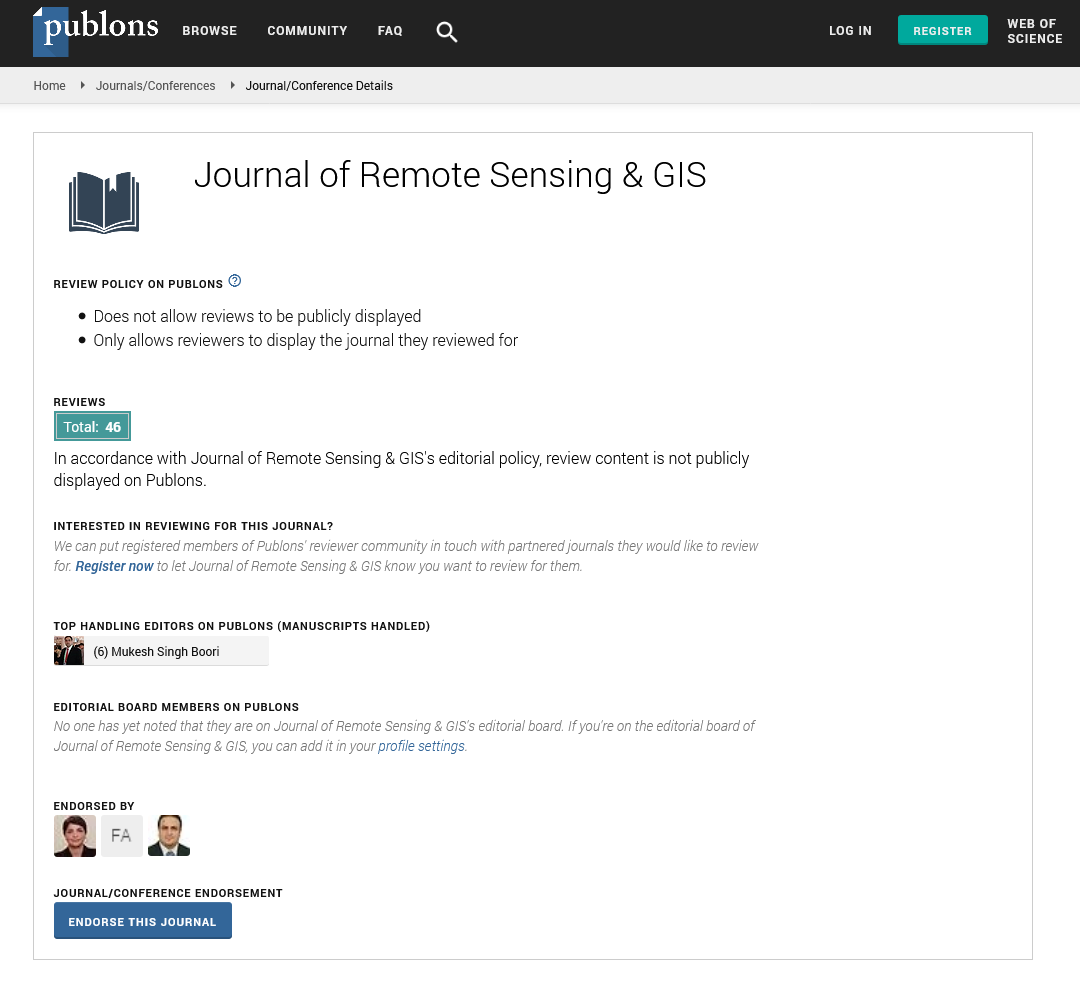Indexed In
- Open J Gate
- RefSeek
- Hamdard University
- EBSCO A-Z
- OCLC- WorldCat
- Publons
- International Scientific Indexing
- Euro Pub
- Google Scholar
Useful Links
Share This Page
Journal Flyer

Open Access Journals
- Agri and Aquaculture
- Biochemistry
- Bioinformatics & Systems Biology
- Business & Management
- Chemistry
- Clinical Sciences
- Engineering
- Food & Nutrition
- General Science
- Genetics & Molecular Biology
- Immunology & Microbiology
- Medical Sciences
- Neuroscience & Psychology
- Nursing & Health Care
- Pharmaceutical Sciences
Commentary - (2024) Volume 13, Issue 3
Evaluating the Impact of Climate Change on Water Resources using Remote Sensing and GIS
Liang Xiang*Received: 26-Aug-2024, Manuscript No. JGRS-24-26968; Editor assigned: 29-Aug-2024, Pre QC No. JGRS-24-26968 (PQ); Reviewed: 13-Sep-2024, QC No. JGRS-24-26968; Revised: 20-Sep-2024, Manuscript No. JGRS-24-26968 (R); Published: 27-Sep-2024, DOI: 10.35248/2469-4134.24.13.350
Description
Climate change has significant impacts on water resources worldwide, affecting both the availability and quality of water. This study focuses on evaluating these impacts using Remote Sensing (RS) and Geographic Information System (GIS) technologies. Through satellite data and spatial analysis, RS and GIS offer valuable tools for monitoring water bodies, detecting changes in precipitation patterns and assessing the vulnerability of watersheds. Climate change has been increasingly recognized as a primary driver of environmental transformation, with water resources being one of the most affected sectors. Rising temperatures, altered precipitation patterns and the increasing frequency of extreme weather events such as droughts and floods disrupt the natural hydrological cycle. Understanding these changes is important for the management and conservation of water resources.
Traditional methods of monitoring water resources are often inadequate in capturing large-scale and dynamic changes over time. Remote Sensing (RS) and Geographic Information Systems (GIS) have emerged as important tools in providing accurate, timely and spatially comprehensive data for assessing the impacts of climate change on water resources.
Evaluating climate change impact on water resources
Various methods for evaluating climate change impact on water resources are:
Monitoring surface water bodies: Changes in the availability of surface water (e.g., rivers, lakes, reservoirs) are among the most visible impacts of climate change. Remote sensing provides continuous, large-scale monitoring of these water bodies. Through multi-temporal analysis, satellite data can detect changes in surface water extent, volume and seasonal variability over time. Landsat and Sentinel-2 are some of the common satellite platforms used to assess surface water resources.
GIS, in combination with RS, is used to process these satellite images and derive spatial statistics. Hydrological models integrated into GIS can further predict the impact of temperature increases and altered rainfall patterns on surface water availability.
Assessing precipitation and hydrological cycle: Precipitation is a primary driver of water availability. Satellite-based sensors such as the Tropical Rainfall Measuring Mission (TRMM) and the Global Precipitation Measurement (GPM) provide near-real-time precipitation data, important for assessing climate variability. Using RS data, long-term precipitation trends can be observed, helping to analyze how climate change has influenced rainfall distribution, intensity and frequency. GIS tools enable spatial mapping of precipitation patterns and allow researchers to assess their effect on local hydrological cycles. This is important in regions where droughts are becoming more frequent due to climate change, affecting both surface and groundwater resources.
Groundwater monitoring: Groundwater is another vital water resource, especially in arid and semi-arid regions. The Gravity Recovery and Climate Experiment (GRACE) satellite system measures changes in Earth’s gravitational field, providing insight into groundwater storage. RS technology can track changes in aquifer levels over time, offering an invaluable perspective on the depletion of groundwater due to overuse and climate-induced alterations. GIS is used to map groundwater recharge zones, integrate RS data with hydrogeological models and assess areas of high risk due to water table depletion.
Drought and flood risk analysis: Droughts and floods are two extreme events exacerbated by climate change. RS data, especially thermal and radar sensors, are effective in detecting soil moisture levels and evaluating the extent of drought-affected areas. Drought indices like the Normalized Difference Vegetation Index (NDVI) and Soil Moisture Index (SMI) derived from remote sensing data are used for monitoring droughts over large geographical scales.
Floods, on the other hand, can be predicted and monitored by analyzing river discharge, precipitation and land cover change using remote sensing. Synthetic Aperture Radar (SAR) sensors, which can penetrate cloud cover, are especially useful for flood monitoring in real-time.
In GIS, spatial layers representing flood zones, infrastructure vulnerability and population density are combined to assess flood risk. Predictive models built into GIS help to identify areas prone to future flood events under changing climatic conditions.
Conclusion
The evaluation of climate change impacts on water resources requires innovative approaches that can capture spatial and temporal variations. Remote sensing and GIS technologies provide invaluable data and tools to assess changes in surface and groundwater, precipitation patterns and extreme events like droughts and floods. By integrating these technologies, we can better understand the dynamics of climate change and its effects on water resources, informing future policy decisions and management strategies to ensure sustainable water availability in a changing climate.
Citation: Xiang L (2024). Evaluating the Impact of Climate Change on Water Resources using Remote Sensing and GIS. J Remote Sens GIS. 13:350.
Copyright: © 2024 Xiang L. This is an open-access article distributed under the terms of the Creative Commons Attribution License, which permits unrestricted use, distribution and reproduction in any medium, provided the original author and source are credited.

